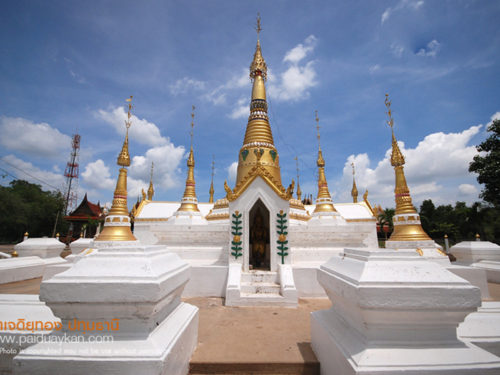Wat Phra Dhammakaya
Wat Phra Dhammakaya (Thai: วัดพระธรรมกาย; RTGS: Wat Phra Thammakai; IPA: [wát pʰráʔ tʰam.má.kaːj]) is a Buddhist temple (wat) in Khlong Luang District, in the Pathum Thani Province north of Bangkok, Thailand. It was founded in 1970 by the maechi (nun) Chandra Khonnokyoong and Luang Por Dhammajayo. It is the best-known and the fastest growing temple of the Dhammakaya Tradition. This tradition, teaching Dhammakaya meditation (Vijja Dhammakaya), was started by the teacher Luang Pu Sodh Candasaro in the early-20th century.
Wat Phra Dhammakaya is one of the temples that emerged from this tradition and is part of the Mahanikaya fraternity. The temple is legally represented by the Dhammakaya Foundation. It aims to adapt its traditional Buddhist values in modern society. It deploys modern technology, marketing methods and interprets Buddhist doctrines in ways that have led to controversy and a government crackdown. The temple plays a leading role in Thai Buddhism with theologian Edward Irons describing it as “the face of modern Thai Buddhism”.
Initially, the temple was founded as a meditation center, after Maechi Chandra and the just ordained monk Luang Por Dhammajayo could no longer accommodate the rising number of participants in activities at Wat Paknam Bhasicharoen. The center became an official temple in 1977. The temple grew exponentially during the 1980s, when the temple’s programs became widely known among the urban middle class. Wat Phra Dhammakaya expanded its area and the building of a huge stupa (pagoda) was started.
During the period of the 1997 Asian financial crisis, the temple was subject to widespread criticism for its fundraising methods and teachings, as Luang Por Dhammajayo was charged with embezzlement and removed from his office as abbot. In 2006, the charges were withdrawn and he was restored as abbot. The temple grew further and became known for its many projects in education, promotion of ethics, and scholarship. The temple also became accepted as part of the mainstream Thai Sangha (monastic community).
During the 2014 military junta, the abbot and the temple were put under scrutiny again and Luang Por Dhammajayo was accused of receiving stolen money from a supporter and money-laundering. The temple has been referred to as the only influential organization in Thailand that has yet to be subdued by the ruling junta, which has shut down most opposition since taking power. The judicial processes against the abbot and the temple since the 1990s have led to much debate regarding the procedures and role of the state towards religion, a debate that has intensified during the 2017 lockdown of the temple by the junta. As of 2017, the whereabouts of Luang Por Dhammajayo was still unknown, and in 2018, Phrakhru Sangharak Rangsarit was designated as the official abbot.
Wat Phra Dhammakaya emphasizes a culture of making merit through doing good deeds and meditation, as well as an ethical outlook on life. The temple promotes a community of kalyanamittas (‘good friends’) to achieve its vision. In its beginnings, the temple emphasized mostly the teaching of meditation, then later emphasized fundraising more.
Finally, the temple broadened its activities to include more engagement in society. The temple uses a satellite television station and a distance-learning university. In its large temple complex, the temple houses several monuments and memorials, and in its construction designs traditional Buddhist concepts are given modern forms. The temple aims to become a global spiritual center to help cultivate its slogan “World Peace through Inner Peace”. As of 2017, the number of followers was estimated at three million people worldwide.












